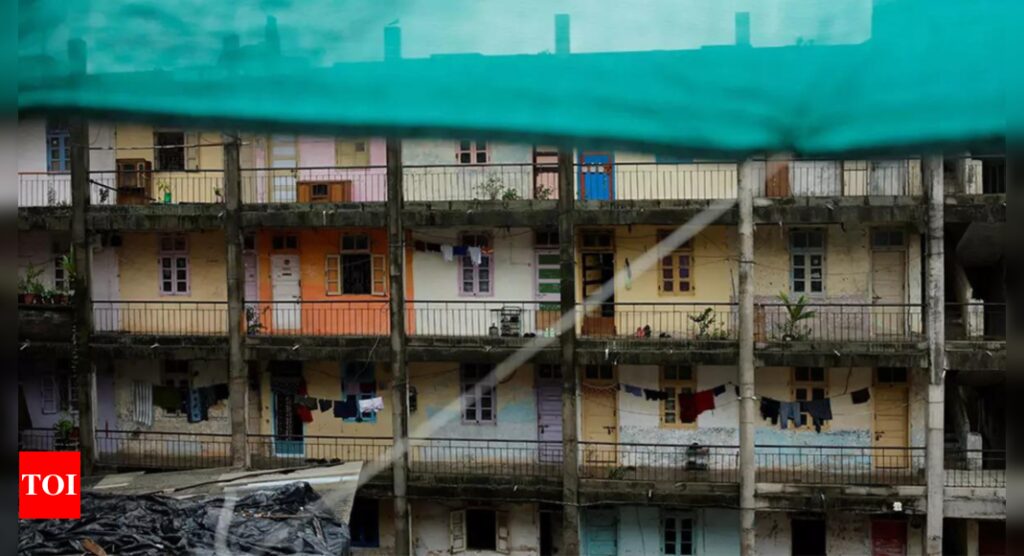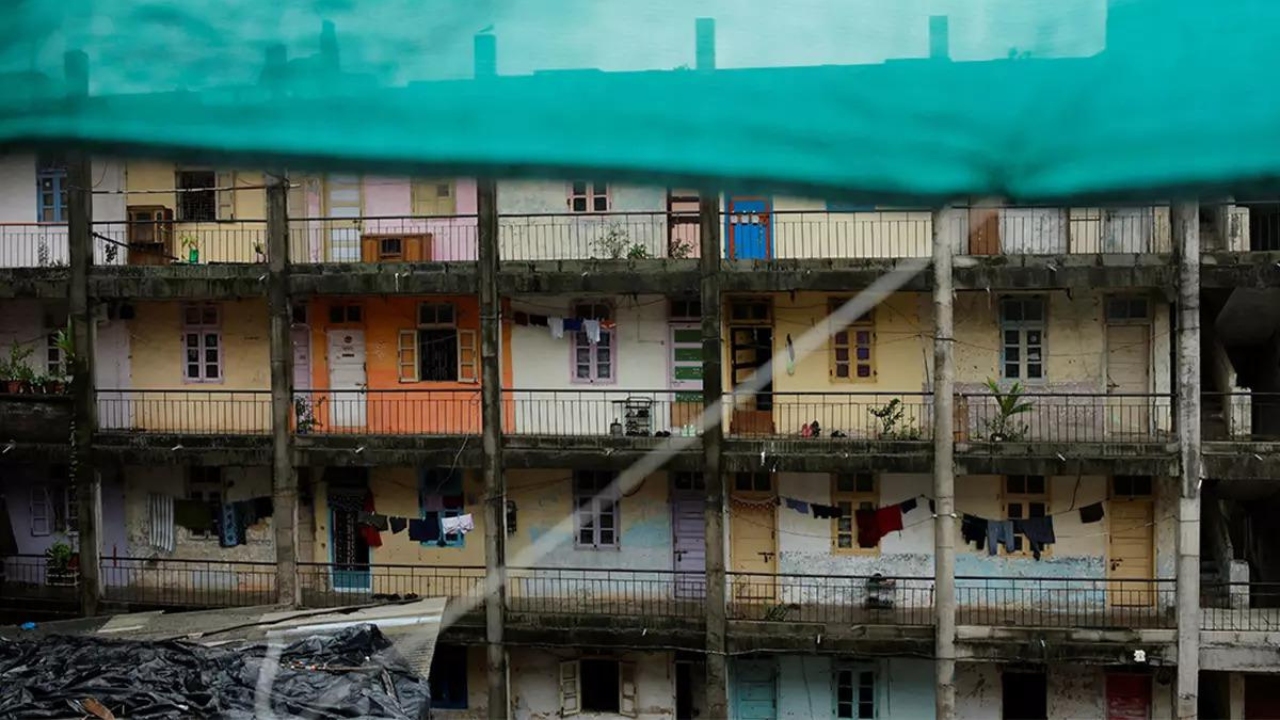[ad_1]
MUMBAI: “South Bombay? 1BHK? Aa jao, boss. Dikha doonga,” promises the young man, inviting you into a claustrophobic chawl room-sorry “master bedroom”-with a train-seat-like bed. At the end of the quick tour through the almirah-sized “attached bathroom” attached to which was a greasy geyser aka ‘greaser’ and the “terrace” whose walls seemed to touch the fingers of his outstretched hands, he deadpans: “South Bombay hai, compromise toh karna padega boss.” Instead of making them laugh, this recent viral video sending up typical Indian brokers triggered flashbacks from Richa Harpalani and Ankita Singh (name changed) of the compromise that turned them from flatmates to roommates a few months ago.
The two single women used to live in a Rs 16,000-a-month 1BHK near Thane station a few months ago when they set out to look for a home of a similar size and price in the heart of the city. The quest led the 28-year-olds up and down a series of peeling buildings in Sion and Matunga, including one whose rickety stairs were so narrow that they could not imagine hauling even a single bed to the fourth-floor single-bedroom. “That’s okay,” shrugged the broker when the duo complained. “You are getting a terrace where you can party with your friends”. Today, the former flatmates share a room in a Rs 38,000-a-month 2BHK in Kurla.
The point is if you are looking for a one BHK in south or even central Mumbai, compromise toh karna padega. Statistics suggest that studio apartments are quietly doing what BEST double-deckers did loudly: vanish. In just a year between 2021 and 2022, the projects offering these compact units in Mumbai Metropolitan Region (MMR) fell from 115 to 71, shows data from property consultants ANAROCK; a recent study by property site Magicbricks stated that 1 BHKs now account for barely 27% of the total demand and supply across cities in India. Though the share of studio apartments in new constructions was rising post-2017, things took a sharp turn in 2020 when lifestyle changes, remote working and co-living increased the collective hunger for larger units and amenities, say experts. “The demand for studio apartments was severely dented post the pandemic,” says Anuj Puri, chairman, ANAROCK Group.
Simran Ahuja-who lived in a cozy 1BHK until work transplanted her to Delhi-says she confidently asked brokers to look for a pocket-friendly compact unit in central Mumbai when she decided to move back. “I was surprised when most brokers told me that in areas like Sion, Matunga and Dadar, where I wanted to live, there weren’t any new 1BHKs,” says the 37-year-old who now shares an Andheri 2BHK with a friend. Most studio apartments are in smaller projects undertaken by lesser-known builders and, like auto-rickshaws, you’ll find them chiefly beyond the island city, spelling doom for many such as Shruti Jain, a 28-year-old single woman who wanted even less room than Ahuja. “I wanted a one room kitchen near my office that would be economical and easy to maintain as a working professional,” says Jain, a consultant in Vile Parle. “But most of the brokers I met told me that the only 1RKs I would find are in Thane, Navi Mumbai or other such far locations which are at quite a distance from my workplace,” says Jain who now lives in a Kurla 2 BHK.
Ritesh Mehta knows why. “People want more spacious homes that accommodate their evolving needs, such as dedicated workspaces or areas for hobbies,” says Mehta, senior director, JLL, who has observed many 1BHK owners search for 2BHKs post-pandemic. “Before Covid, 60-65% of house hunters were first-time buyers and the rest 30-35% were the ones who were upgrading. But now the trend has reversed,” says Mehta, adding that 2 BHKs fetch builders larger profits. Which explains the phasing out of 1BHKs in the wake of post-pandemic redevelopment.
“2BHK is a requirement, 1BHK is an adjustment,” says Vikas Jain, CEO of Labdhi Lifestyle, attributing the current buyer mood to rising affordability and improved connectivity. Pointing out that real estate prices have remained stagnant for the last ten years even as incomes have risen by “150 to 200 per cent”, Jain says with new metro lines cutting down commute time, home-buyers would rather shell out slightly more for a 2BHK in a suburb rather than a 1BHK in the city’s tummy.
Jain-whose firm is building the city’s first tower dedicated to co-living at Wadala-also points out the growing need among the young to flee rent agreements and broker hassles. Many floors in the Wadala highrise would cater to young professionals who want to be rid of renewing rental apartments every 11 months. Ranging from Rs 30,000 to Rs 40,000, monthly rents of these 1 BHK and 2 BHK co-living flats, however, appear steep compared to rental apartments, admits Jain. “It’s not an apple-to-apple comparison,” he says, adding that co-living makes sense for those looking for convenience, utilities including meals and accommodation on a temporary basis.
The two single women used to live in a Rs 16,000-a-month 1BHK near Thane station a few months ago when they set out to look for a home of a similar size and price in the heart of the city. The quest led the 28-year-olds up and down a series of peeling buildings in Sion and Matunga, including one whose rickety stairs were so narrow that they could not imagine hauling even a single bed to the fourth-floor single-bedroom. “That’s okay,” shrugged the broker when the duo complained. “You are getting a terrace where you can party with your friends”. Today, the former flatmates share a room in a Rs 38,000-a-month 2BHK in Kurla.
The point is if you are looking for a one BHK in south or even central Mumbai, compromise toh karna padega. Statistics suggest that studio apartments are quietly doing what BEST double-deckers did loudly: vanish. In just a year between 2021 and 2022, the projects offering these compact units in Mumbai Metropolitan Region (MMR) fell from 115 to 71, shows data from property consultants ANAROCK; a recent study by property site Magicbricks stated that 1 BHKs now account for barely 27% of the total demand and supply across cities in India. Though the share of studio apartments in new constructions was rising post-2017, things took a sharp turn in 2020 when lifestyle changes, remote working and co-living increased the collective hunger for larger units and amenities, say experts. “The demand for studio apartments was severely dented post the pandemic,” says Anuj Puri, chairman, ANAROCK Group.
Simran Ahuja-who lived in a cozy 1BHK until work transplanted her to Delhi-says she confidently asked brokers to look for a pocket-friendly compact unit in central Mumbai when she decided to move back. “I was surprised when most brokers told me that in areas like Sion, Matunga and Dadar, where I wanted to live, there weren’t any new 1BHKs,” says the 37-year-old who now shares an Andheri 2BHK with a friend. Most studio apartments are in smaller projects undertaken by lesser-known builders and, like auto-rickshaws, you’ll find them chiefly beyond the island city, spelling doom for many such as Shruti Jain, a 28-year-old single woman who wanted even less room than Ahuja. “I wanted a one room kitchen near my office that would be economical and easy to maintain as a working professional,” says Jain, a consultant in Vile Parle. “But most of the brokers I met told me that the only 1RKs I would find are in Thane, Navi Mumbai or other such far locations which are at quite a distance from my workplace,” says Jain who now lives in a Kurla 2 BHK.
Ritesh Mehta knows why. “People want more spacious homes that accommodate their evolving needs, such as dedicated workspaces or areas for hobbies,” says Mehta, senior director, JLL, who has observed many 1BHK owners search for 2BHKs post-pandemic. “Before Covid, 60-65% of house hunters were first-time buyers and the rest 30-35% were the ones who were upgrading. But now the trend has reversed,” says Mehta, adding that 2 BHKs fetch builders larger profits. Which explains the phasing out of 1BHKs in the wake of post-pandemic redevelopment.
“2BHK is a requirement, 1BHK is an adjustment,” says Vikas Jain, CEO of Labdhi Lifestyle, attributing the current buyer mood to rising affordability and improved connectivity. Pointing out that real estate prices have remained stagnant for the last ten years even as incomes have risen by “150 to 200 per cent”, Jain says with new metro lines cutting down commute time, home-buyers would rather shell out slightly more for a 2BHK in a suburb rather than a 1BHK in the city’s tummy.
Jain-whose firm is building the city’s first tower dedicated to co-living at Wadala-also points out the growing need among the young to flee rent agreements and broker hassles. Many floors in the Wadala highrise would cater to young professionals who want to be rid of renewing rental apartments every 11 months. Ranging from Rs 30,000 to Rs 40,000, monthly rents of these 1 BHK and 2 BHK co-living flats, however, appear steep compared to rental apartments, admits Jain. “It’s not an apple-to-apple comparison,” he says, adding that co-living makes sense for those looking for convenience, utilities including meals and accommodation on a temporary basis.
[ad_2]
Source link











More Stories
We can’t wait to face India in the final: Pat Cummins | Cricket News
Railways plans 3,000 additional trains in next 4-5 years to minimise number of waitlisted tickets | India News
Faridabad: Man dies after ‘falling from hotel room window’ while partying with friends